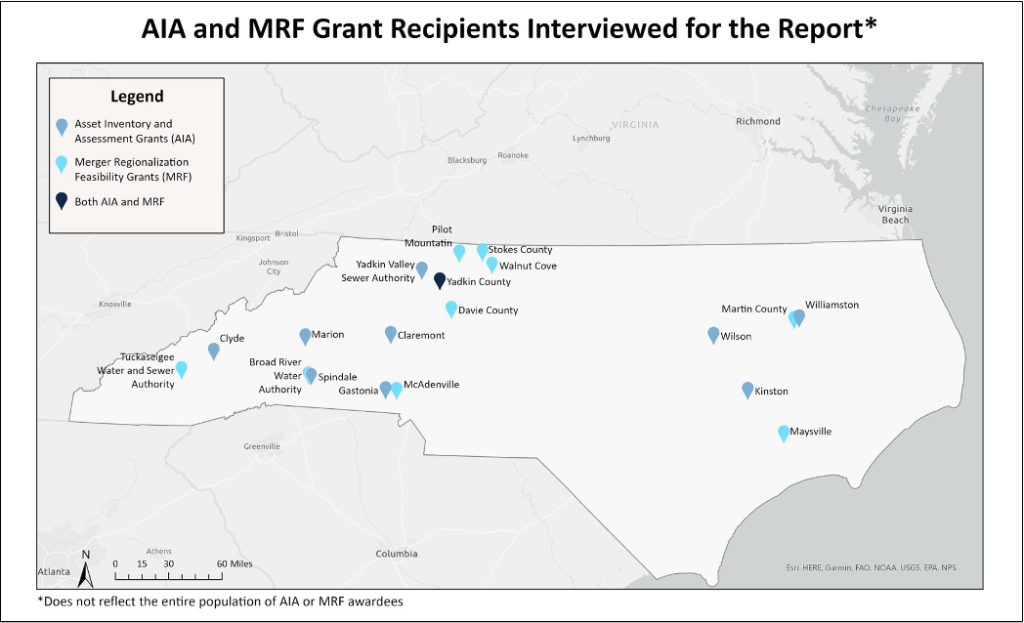By Austin Thompson-Spain, Associate Director, UNC Environmental Finance Center
During the summer of 2023, the UNC Environmental Finance Center (UNC EFC), as part of a contract with the NC Division of Water Infrastructure (DWI), conducted a series of interviews with recipients of grants from two DWI programs: the Asset Inventory and Assessment (AIA) and Merger/Regionalization Feasibility (MRF) grant programs. Through these interviews, the UNC EFC aimed to evaluate the programs by understanding how the funding was used, the recipients’ experience with the grant program, the benefits received or anticipated to receive from the grant programs, and any challenges encountered. With this information, the UNC EFC intended to make recommendations to DWI regarding grant program operations, expansions, or changes.
So, what are AIA and MRF grants? What do these grant programs fund, and who can apply? First, starting with the AIA grant program, AIA grants are designed to increase utility sustainability and viability by funding activities that assess the current condition of water and wastewater systems and plan for future capital needs. The funds may be used to create an asset inventory, create maps and databases of system assets, conduct a risk assessment of assets, create a capital improvement plan, or conduct rate studies. MRF grants are also designed to increase utility viability and sustainability by funding studies of potential regionalization efforts between utilities. MRF grant funds may be used to conduct studies to evaluate the potential consolidation of two or more systems into one system or to evaluate the potential physical interconnection between systems for regional service. Both programs are available to NC local government units (LGUs). In short, both programs are rooted in state-level efforts to increase local government utility viability.
To evaluate the programs, the UNC EFC interviewed ten recipients for each program (20 total). These interviewees were split across the western and eastern parts of the state and reflected a variety of utility sizes.
Each recipient was asked eight to nine questions, two of which were general and asked of all recipients. The others were program-specific, aiming to understand each grant’s specific outputs and outcomes.
General Interview Topics:
| Asset Inventory and Assessment | Merger/Regionalization Feasibility |
| Rate the success of the grant project (1-5); explain why that number was selected | |
| Goals of the grant project, explanation of if those goals were achieved | |
| Frequency that asset management plans (AMPs) are reviewed, used, and updated | Formal or informal collaborations resulting from the MRF grant project |
| Benefits provided by AIA to utility and customers (e.g., creation of KPIs, improvements in level of service) | Anticipated partnerships or collaborations resulting from the MRF grant project |
| Infrastructure projects resulting from AIA | Challenges of the MRF grant program (e.g., political, financial, geographic barriers) |
| Technical, managerial, or financial changes resulting from AIA | Benefits of the MRF grant program |
| Things recipients would do differently if able to redo their AIA | Things recipients would do differently if able to redo their MRF |
| Organizational changes resulting from the MRF grant | |
The interviews varied in length and detail but provided ample qualitative data to evaluate. To analyze the interviews and produce high-level findings, the UNC EFC team recorded, transcribed, and coded the interviews for key programmatic takeaways from each grant (i.e., AIA and MRF) and overarching takeaways across both programs. These takeaways were paired with salient quotes from interviewees and shared with DWI in the form of a final report and a presentation.
Many key takeaways could be valuable to DWI as the programs evolve. Notably, the two programs are very different. They offer different sets of benefits and present a different set of challenges for recipients. AIAs tend to be straightforward and predictable, with a relatively short list of project deliverables to choose from that tend to be familiar to utility staff as they reflect the components of an Asset Management Plan. In contrast, MRFs are broad and flexible, designed to accommodate a variety of merger or regionalization considerations (e.g., physical, financial, political, etc.) and options (e.g., consolidating systems, partnering on treatment, etc.).
This blog only scratches the surface of this evaluation’s findings. To learn more about this project and dig deeper into the findings from this work, check out the full report on the UNC EFC website.
Need technical assistance? The UNC Environmental Finance Center is here to help!
The Environmental Finance Center at UNC-CH offers free one-on-one technical assistance for small water systems. If you are interested in our support, fill out our Technical Assistance Request Form or contact us at efc@sog.unc.edu.



